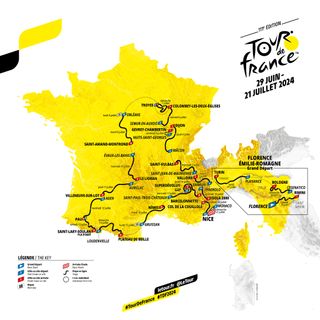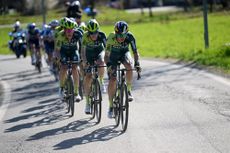Tour de France 2024 route: Two individual time trials, five summit finishes and gravel sectors
Tour de France 2024 route totals 3,492km of racing with 52,320 metres of overall elevation across 21 stages


The Tour de France 2024 route will include five summit finishes, 59km of individual time trialling, and gravel sectors on stage nine, it has been announced by its organiser ASO.
The route for the 111th edition of the race was unveiled in a presentation inside Paris's Palais des Congrès on Wednesday.
It begins on the 29 June, and finishes on the 21 July, three weeks later.
As was confirmed last year, the race will begin in Italy for the first time, with stages from Florence to Rimini, Cesenatico to Bologna and Piacenza to Turin. It will mark 100 years since the first Italian winner of the Tour, Ottavio Bottecchia.
Another first is that the Tour will not conclude in Paris for the first time ever, due to the 2024 Paris Olympics, with the final stage coming in Nice. It also means that for the first time since 1989, the final stage will be contested, in a time trial.
On the way, the race tackles the Alps, the Massif Central and the Pyrenees, including four summit finishes at Pla d'Adet, the Plateau de Beille, Superdévoluy, Isola 2000 and the Col de la Couillole, and 59 kilometres of time trialling across stages seven and 21.
There are 14 gravel sectors on stage nine from Troyes to Troyes, totalling 32km, with six packed into the final 35km in what could be a decisive point of the race. The longest is 4km.
Get The Leadout Newsletter
The latest race content, interviews, features, reviews and expert buying guides, direct to your inbox!
With the final day a hilly time trial in Nice and not the usual procession in to Paris, it is hoped that the race will be alive right to the end of the race. The whole final week, in fact, will be crucial for general classification, with four of the six days potentially decisive.
According to the race organisers, there are eight sprint opportunities along the way, although some are not as straightforward as others, with a breakaway sure to contest some of them. Mark Cavendish will be looking forward to Saint-Amand-Montrond on stage 13, where he won in 2013, and Nîmes on stage 16 especially, where he won in 2008.
Last year, the race was dominated by Jonas Vingegaard (Jumbo-Visma), who crushed all of his competition, including Tadej Pogačar (UAE Team Emirates), on the stage 16 time trial to Combloux and stage 17's summit finish in Courchevel.
Tour de France 2024 route: stage by stage
| Stage | Date | Start | Finish | Distance | Profile |
| 1 | 29 June | Florence | Rimini | 206km | Hilly |
| 2 | 30 June | Cesenatico | Bologna | 200km | Hilly |
| 3 | 1 July | Piacenza | Turin | 229km | Flat |
| 4 | 2 July | Pinerolo | Valloire | 138km | Mountains |
| 5 | 3 July | Saint-Jean-de-Maurienne | Saint-Vulbas Plaine de l'Ain | 177km | Hilly |
| 6 | 4 July | Mâcon | Dijon | 163km | Flat |
| 7 | 5 July | Nuits-Saint-Georges | Gevrey-Chambertin | 25km | ITT |
| 8 | 6 July | Semur-en-Auxois | Colombey-les-Deux-Églises | 176km | Flat |
| 9 | 7 July | Troyes | Troyes | 199km | Hilly/Gravel |
| 10 | 9 July | Orléans | Saint-Amand-Montrond | 187km | Flat |
| 11 | 10 July | Évaux-les-Bains | Le Lioran | 211km | Medium mountains |
| 12 | 11 July | Aurillac | Villeneuve-sur-Lot | 204km | Flat |
| 13 | 12 July | Agen | Pau | 171km | Flat |
| 14 | 13 July | Pau | Saint-Lary-Soulan Pla d'Adet | 152km | Mountains |
| 15 | 14 July | Loudenvielle | Plateau de Beille | 198km | Mountains |
| 16 | 16 July | Gruissan | Nîmes | 187km | Flat |
| 17 | 17 July | Saint-Paul-Trois-Châteaux | Superdévoluy | 178km | Mountains |
| 18 | 18 July | Gap | Barcelonnette | 179km | Hilly |
| 19 | 19 July | Embrun | Isola 2000 | 145km | Mountains |
| 20 | 20 July | Nice | Col de la Couillole | 133km | Mountains |
| 21 | 21 July | Monaco | Nice | 34km | ITT |
Full Tour de France 2024 route map

Tour de France 2024 route week one
The 2024 Tour de France begins how it means to go on, with a lot of climbing. Stage one begins in Florence, and includes 3,800km over 205km, the most ever in an opening stage, according to race director Christian Prudhomme.
The second stage is also hilly, starting from Marco Pantani's hometown of Cesenatico, finishing in Bologna through Emilia-Romagna. It copies the route of the Giro dell'Emilia, including the final climb of San Luca - 1.9km at 10.6 per cent - which is tackled twice.
There is a chance for the fast men on stage three, which covers 225km from Piacenza to Turin.
Stage four sees the race finally reach France, via the Alps. The Sestriere, the Col de Montgenèvre and the Col du Galiber are all tackled before a descent to Valloire.
Stages five and six, to Saint-Vulbas and Dijon, should be sprint opportunities, but the fast men could be ambushed.
The race's first individual time trial comes on stage seven, but it will be a technical affair as opposed to a pure rouleur's course, before stage eight should be another chance for the sprinters.
Stage nine could be the highlight of the opening week, and is certainly something new, using the gravel roads of the Champagne region to mix things up. The 32km of gravel across 14 sectors is inspired from the Tour de France Femmes 2022, which used two of the same tracks; it is the biggest use of gravel at the Tour to date.
Tour de France 2024 route week two
After a rest day in Orléans, the closest to Paris the race gets in 2024, there are four stages which head south towards the Pyrenees.
Stage ten will surely be a sprint stage, but the winds could blow, as they did in 2013, when Cavendish won, while stage 11 is a return to medium mountains. The stage to Le Lioran is similar to the one which Greg Van Avermaet triumphed on in 2016, taking the yellow jersey in the process. 4,500m of climbing will make this a tough test for everyone.
It's back to sprinting or breakaways on stages 12 and 13 to Villeneuve-sur-Lot and Pau, respectively, with the latter looking more nailed on for a bunch finish.
Stage 14 is the first Pyrenean test, finishing atop the Pla d'Adet, which marks Raymond Poulidor's victory up there 50 years ago; it follows the Col du Tourmalet and the Hourquette d’Ancizan in just 152 km.
After that, the climbing does not stop. On Bastille Day, Catorze Juillet, the race heads from Loudenvielle to Plateau de Beille, in a stage that covers 198 km, with 4,850 metres of climbing. The Peyresourde is tackled first, followed by the Col de Menté, the Col de Portet d’Aspet, the Col de la Core, and Col d’Agnès, before the final test to Plateau de Beille. It will surely help decide the direction of the race.
Tour de France 2024 route week three
A classic transition stage follows the second rest day from Gruissan to Nîmes, which is planned as a sprint stage, but if the winds blow, mayhem could ensue.
Stage 17 is a return to the mountains with a finish in the ski resort of Superdévoluy on the fringes of the Alps, before stage 18 looks set to be a breakaway day as the race travels from Gap to Barcelonnette.
It is the final three days where the 2024 champion will be crowned, however, with two back-to-back summit finishes in southeast France. Stage 19 finishes atop Isola 2000, with the Col de Vars, at 2,120m, before the Col de la Bonnette, at 2,802m, marks the high point of the race, and then there's Isola 2000.
Stage 20 feels like a Paris-Nice penultimate stage, and kind of is, with some of the favourite climbs from the race tackled consecutively. The Col de Braus is first, 10.2km at 6.3 per cent, before the Col de Turini, 20.6km at 5.6 per cent, and then the Col de La Colimiane, 7.6km at 6.8 per cent, and then, finally the Col de la Couillole, 15.7km at 7.1 per cent. That's 4,500m of elevation in just 132km.
However, that is not the end of the race. This year, there is a final day time trial around Nice, not a procession in Paris. The 35km course includes La Turbie, 8.1km at 5.6 per cent, and the Col d’Eze, 1.6km at 8.1%, before concluding on the Promenade des Anglais.

Thank you for reading 20 articles this month* Join now for unlimited access
Enjoy your first month for just £1 / $1 / €1
*Read 5 free articles per month without a subscription

Join now for unlimited access
Try first month for just £1 / $1 / €1

Adam is Cycling Weekly’s news editor – his greatest love is road racing but as long as he is cycling on tarmac, he's happy. Before joining Cycling Weekly he spent two years writing for Procycling, where he interviewed riders and wrote about racing. He's usually out and about on the roads of Bristol and its surrounds. Before cycling took over his professional life, he covered ecclesiastical matters at the world’s largest Anglican newspaper and politics at Business Insider. Don't ask how that is related to cycling.
-
 ‘It is a rallying cry for change’ - The White Line Foundation honors teen cyclist killed by driver with memorial ride
‘It is a rallying cry for change’ - The White Line Foundation honors teen cyclist killed by driver with memorial rideMagnus White, 17, was struck and killed by a driver while on a training ride in Boulder, Colorado, last year
By Kristin Jenny Published
-
 Zwift issues 38% monthly subscription hike
Zwift issues 38% monthly subscription hikeThe change will allow a better user experience, insists the virtual riding platform
By James Shrubsall Published
-
 New team philosophy, no foreign investment and Red Bull helmets: Inside the Red Bull-Bora-Hansgrohe deal
New team philosophy, no foreign investment and Red Bull helmets: Inside the Red Bull-Bora-Hansgrohe dealTeam CEO Ralph Denk says further big money signings, similarly to Primož Roglič, are unlikely as Red Bull money gives German team wings
By Tom Thewlis Published
-
 From 'best condition ever' to 'worst' - Wout van Aert reflects on crashing out of Classics
From 'best condition ever' to 'worst' - Wout van Aert reflects on crashing out of ClassicsVisma-Lease a Bike rider rues his misfortune in team documentary after Spring campaign wiped out by crash
By Tom Thewlis Published
-
 Tour de France stage winner leaves hospital, one month after being hit by car driver
Tour de France stage winner leaves hospital, one month after being hit by car driverLennard Kämna to fly home to Germany to begin rehabilitation after incident in Tenerife last month
By Tom Thewlis Published
-
 Wout van Aert back on drop bars as he says he’s 'almost professional again' in Strava post
Wout van Aert back on drop bars as he says he’s 'almost professional again' in Strava postVisma-Lease a Bike rider broke his collarbone, sternum and several ribs in a high speed crash at Dwars door Vlaanderen
By Tom Thewlis Published
-
 Jonas Vingegaard leaves hospital after Itzulia Basque Country horror crash
Jonas Vingegaard leaves hospital after Itzulia Basque Country horror crashDanish rider underwent surgery to repair broken collarbone; too early to know whether Tour de France return will be possible
By Tom Thewlis Published
-
 Will the Tour de France be won by the last man standing?
Will the Tour de France be won by the last man standing?With Jonas Vingegaard, Remco Evenepoel and Primož Roglič hitting the deck at Itzulia Basque Country, all three now face battle to get their seasons back on track
By Adam Becket Published
-
 Tom Pidcock unable to bear weight on right leg after Itzulia Basque Country crash
Tom Pidcock unable to bear weight on right leg after Itzulia Basque Country crashBritish rider crashed during recon of opening stage time trial last weekend and injured his right hip
By Tom Thewlis Published
-
 Mark Cavendish to miss Scheldeprijs as illness continues to affect schedule
Mark Cavendish to miss Scheldeprijs as illness continues to affect scheduleCavendish will ride Presidential Cycling Tour of Türkiye later this month, Astana Qazaqstan confirms
By Tom Thewlis Published